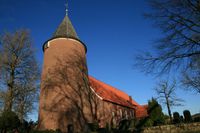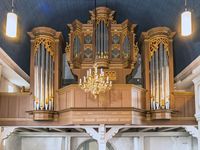53°35'30.1"N 9°33'28.8"E
The church of Hollern, St. Mauritius
Settlement history
The first human traces in the Altes Land dating from around 2000 B.C. have been found in the form of Stone Age weapons. The settlement of the high marshland near Stade and Neuenfelde, directly at the Elbe, probably began around 200 A.D. The soil which was crossed by many tidal creeks had been covered by mud faster and raised higher due to the tides. The first settlers built their still simple homes of wood, clay and reed. They learned to stick thin tree trunks vertically into the ground at equal intervals and to fill the spaces in between with wattle and daub made of reed and straw, which was coated with clay on both sides. On the top of these walls, they erected the gable roof from thinner round timbers, which was covered with reed. All splices were made using willow rods and straps, because wooden connections, such as pegs and dowels as well as nails and screws did not exist at that time. The poor foundations meant that the houses aged no more than 30 years.
The Romantic era started in 750 A.D. and lasted until around 1220. During this time, Christianity arrived in the country. The first churches were built.
The colonisation of the marshy Sietland began in Stade around 1130. Under the guidance of Dutch experts, dykes were built, ditches and Wettern were dug and cultivation was progressed.
The land divisions and field sizes originally brought from the Dutch mother country are still recognisable in the Altes Land today and are literally decisive. The systematic division of the "Hollerland" into long and narrow hides separated by draining ditches, with their gable-ended buildings standing at the head and facing the main roads or the feet of the dykes, gave rise to the Marsch- and Deichhufendörfer.
The name Hollern goes back to the Dutch colonists.
Hollern is a 4 kilometres long typical marshland village. It is located in the “Erste Meile” (first mile). The Dutch land developers established the first of the three large polders here in the Sietland between the rivers Schwinge and Lühe, which are still referred to today as the "Drei Meilen" of the Altes Land.
This place was first mentioned in 1140 A.D. as Thitgerscoph. At that time the Archbishop Adalbert of Hamburg-Bremen gave the Bremen cathedral chapter the tithe “bei Stade in der Marsch, das Thitgerscoph genannt wird”. The syllable "cop" refers to the fact that the settlement sections of the colonisation were called Cope (purchase) according to the Dutch model, regardless of whether a purchase price was paid or not. The syllable "cop" can be found in many Altländer place names - to this day, for example, in the Dritte Meile in the place names Nincop and Francop.
The old place name "Ditgerskop" was finally replaced by "Hollern" in the 17 th century.
St. Mauritius, the church of Hollern
Only a few buildings from the time before the Thirty Years' War have been preserved in the Altes Land. The troops of Reichsmarschall Gottfried Heinrich zu Pappenheim stayed in Stade in the spring of 1632 and set numerous fires in the area. 250 houses burnt down.
The Gothic church tower of St. Mauritius in Hollern is the oldest preserved building in the Altes Land. The massive round tower was built in the Sietland at the beginning of the 13 th century in the course of the Hollerkolonisation. The outer wall is made of brick and is about two metres thick, contains, among other things, granite stone elements that date back to the Romantic era. The massive structure probably provided the community with protection against robbery.
The organ - built by Arp Schnitger - of St. Mauritius church
1575
The organ builder Dirk Hoyer from Hamburg builds a new organ for St. Mauritius Church in Hollern. Based on an invoice addressed to the church, the organ with painted wings is placed on an ’organ chair’ (organ gallery), which is specifically built on the north side of the choir as counterpart to the pulpit. Pulpit and organ are located opposite each other to underline that preaching the gospel in word is equal to preaching the gospel in sound. The newly built organ chair may but must not necessarily indicate that Hoyer’s pipe organ is the first instrument ever located in St. Mauritius Church. However, the following year gives further evidence supporting this assumption.
1576
Almost precisely a year after completing the organ, the list of expenses includes the following item, which says in old German: “Dem Cüster tho win vnd brodt in der Kerken 2 mk”, and in the years to follow it says repeatedly in Latin: “Custodi pro pane & vino”, which both roughly translate as follows: “To the priest for bread and wine.” When looking at the invoice from 1575, the German words “dem Pastore für Brot und Wein” (same meaning as above) are most commonly used. Obviously the church hires a verger (or priest) in 1575 or 1576 who, being a member of Clerus minor (low clergy), is mainly tasked with playing the organ.
1577
First mention of a bellows-treader (German: Calcant) is found in church invoices. He is paid 12 shilling sfor a pair of shoes.
ca. 1675
The parish of Hollern calls on the General Superintendent of Stade to enquire about a new organ. However, the times are not favourable for such a project. The community is heavily burdened. It repeatedly has to accommodate various forces and is expected to make significant contribution payments.
25.11.1685
Damages suffered by St. Catherine’s flood.
28.04.1686
People suffer another storm tide. Destruction of the winter seed and damaged orchards are expected to reduce next years‘ crops. Building new dykes is costly and the Swedish government refuses to waive or defer taxes. Despite these economically difficult times, the parish of Hollern decides to build a new organ. Arp Schnitger, who at that time is causing a furore in the trade, is selected as organ builder.
21.09.1690
Schnitger’s newly built organ with 24 registers (individual sounds) on two manuals and a pedal is inspected and accepted by the organist and composer Vincent Luebeck from Stade. The organ now sits on a newly built gallery in the western part of the church. Directly below the organ gallery is another no longer existing gallery used by a school choir to encourage and support the singing of the congregation. The former existence of two such galleries draws attention to the fact that this period obviously marks the beginning of congregation chanting gradually being accompanied by pipe organ music.
1858
To witness the changing taste in music, Philipp Furtwaengler from Elze is the first to rebuild the shape of the organ.
1963
The company Emanuel Kemper und Sohn (and Son) from Luebeck try to ‘restore’ the organ in a project that completely messes up the organ.
2010/11
The organ building company Ahrend (owned by Hendrik Ahrend, master organ builder from Leer) carries out reconstruction and restoration work on the Schnitger organ and returns it to its original shape.
The company also retunes the organ to its original medium temperament, which today is only present in Schnitger’s organ in Luedingworth after restoration work carried out by the master himself.


